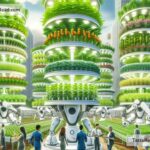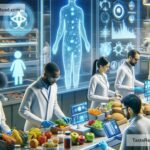The Future of Food Preservation: How Science is Changing What We Eat
Food preservation is one of the most important parts of human history. For thousands of years, humans have used techniques like drying, salting, smoking, fermenting, and later, freezing and canning to keep food fresh for longer. These techniques ensure we can eat food beyond its harvest season, prevent waste, and make sure people everywhere have access to safe, nutritious food. However, as our world changes, so will the ways we preserve food. Scientists, engineers, and food experts are working hard to develop new methods to tackle modern problems like climate change, resource scarcity, and growing populations. What does the future of food preservation look like? Here are some exciting innovations that might transform how we store and eat food.
Smarter Packaging: Save More, Waste Less
One of the biggest advances in food preservation comes from packaging. In the future, we might see “smart packaging” that can monitor the freshness of food. For example, imagine buying a packet of meat with a label that changes color when the food begins to spoil. This would allow you to use the food in time, reducing waste and improving safety.
Additionally, packaging materials may become more eco-friendly. Scientists are creating biodegradable and edible packaging made from natural materials such as seaweed, starch, or proteins. These innovations can help reduce plastic waste while keeping food fresh longer. Some research even suggests that such materials can be infused with antimicrobial substances to protect food from bacteria.
Cold Plasma Technology: Zapping Germs Without Chemicals
Cold plasma is an exciting new technology that could change food preservation. Plasma is like a supercharged gas filled with ions and electrons, which can kill bacteria and viruses without changing the food’s taste, smell, or nutritional value. Unlike traditional methods that rely on heat, cooling, or chemicals, cold plasma is energy-efficient and leaves no harmful residues. It is already being tested on fresh fruits, vegetables, and meat, but scientists believe it could be applied on a larger scale, such as in food factories or packaging plants.
This technology promises a cleaner and safer way to keep food fresh while reducing reliance on chemical preservatives that many people prefer to avoid.
High-Pressure Processing (HPP): Fresh Food Without Compromise
Another futuristic food preservation method is high-pressure processing (HPP). This technique uses extremely high pressure—up to six times stronger than the pressure found at the bottom of the ocean—to kill harmful bacteria and extend shelf life. Unlike traditional methods like freezing or cooking, HPP doesn’t damage the food’s flavor, texture, or nutrients. For example, cold-pressed juices often use HPP to stay fresh without the need for heat-based pasteurization.
In the future, HPP could be used more widely for dairy, meat, seafood, and ready-to-eat meals, offering cleaner labels (fewer artificial additives) and healthier options for consumers.
Nanotechnology: Tiny Particles, Big Benefits
Nanotechnology is the science of tiny particles, and it’s making waves in food preservation research. By manipulating materials at the microscopic level, scientists can develop coatings, additives, or sensors that protect food from spoilage. For example, nanoparticles can be added to packaging to block out oxygen, moisture, and light, all of which can speed up food’s expiration. Nanotechnology might also help create smart sensors that detect contamination or spoilage, improving the safety of our food supply.
While still in its early stages, nanotechnology offers exciting possibilities for extending food’s shelf life while enhancing safety and nutritional value.
Natural Preservatives: Goodbye Artificial Additives
Many people today worry about artificial preservatives in their food. In response, scientists are exploring natural alternatives that can keep food fresh without the need for synthetic chemicals. For instance, researchers are studying essential oils from herbs and spices like rosemary, thyme, and clove for their antimicrobial properties. Additionally, plant-based compounds found in fruits and vegetables may be used to slow spoilage or prevent bacteria from growing.
Fermentation, an ancient technique, is also getting a modern twist. By using specific strains of bacteria or yeast, scientists can create natural preservatives to enhance the flavor and shelf life of food.
3D Printing for Food Preservation?
Believe it or not, 3D printing might play a role in food preservation! As this technology becomes more advanced, scientists are exploring ways to use it to create customized food with longer shelf lives. For example, 3D-printed food could be designed with precise layers of preservatives to keep it fresh. Additionally, it could allow for efficient production, reducing the need for transportation, packaging, and storage.
The Impact of AI and Automation
Artificial intelligence (AI) and automation are not just reshaping industries like manufacturing—they’re also changing food preservation. AI can analyze vast amounts of data to predict when food will spoil, recommend the best preservation methods, or monitor supply chain conditions to reduce waste. Automated systems can process, package, and store food with precision, preventing spoilage and ensuring freshness during transportation.
A Greener Future for Food
Looking ahead, the future of food preservation will be closely tied to environmental sustainability. As climate change continues to affect how and where food is grown, preserving food in eco-friendly ways will become even more important. We will need methods that consume less energy, produce less waste, and rely on renewable materials. Scientists are working on creative solutions, like solar-powered drying systems or low-energy refrigeration methods, to adapt to these challenges.
The Bottom Line
As technology evolves, the future of food preservation looks brighter, smarter, and more sustainable. From cold plasma treatments to biodegradable packaging, these innovations promise healthier, safer, and fresher food for everyone. With the global population growing and environmental concerns rising, new methods of food preservation are more important than ever. While many of these technologies are still being developed, they offer hope for a future where we can reduce waste, fight hunger, and protect the planet—all while enjoying delicious, nutritious food.
The next time you open your fridge or pantry, remember: the way we preserve food might soon be very different, and it could make the world a better place for all of us.


